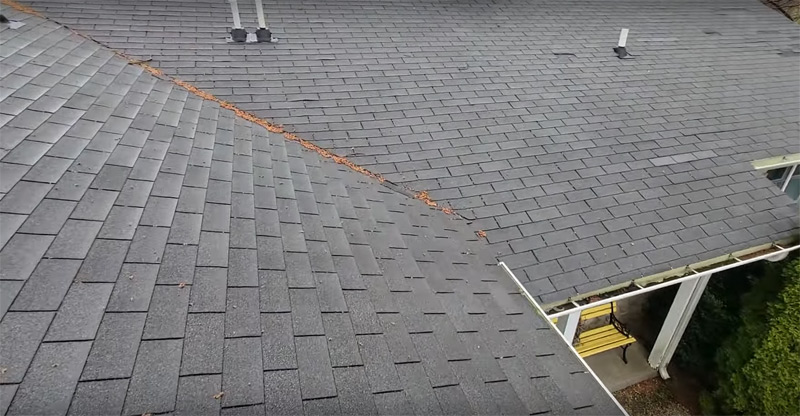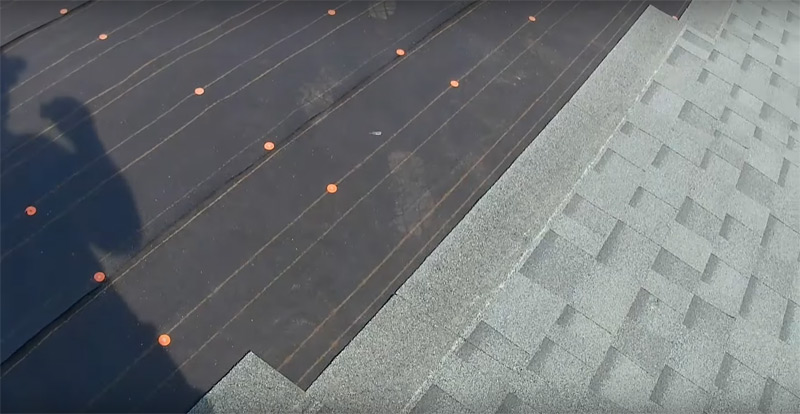Asphalt Shingles Roof Cost In 2024
| 3-tab asphalt | $6,860 - $8,490 |
| Architectural asphalt | $7,400 - $9,900 |
| 3-tab asphalt | $6,860 - $8,490 |
| Architectural asphalt | $7,400 - $9,900 |
On average, 7 out of 10 households in the country are covered with asphalt shingles (fiberglass mat layered between asphalt and mineral/ceramic/stone granules). Although the composition is based on a single technology, there are two main options for asphalt shingles:
While all options provide water-resistant coating, deflection of UV light, and comply with building codes, there are some differences to be aware of when designing a roof. Among them, the most important for the customer are cost and warranty.


3-tab shingles are the least expensive roofing material, costing about 20% less than architectural shingles. However, the low price is often the only advantage. Architectural shingles offer better aesthetics, improved durability, and longer warranties, making them the most popular choice for homeowners. The two-layer design of architectural shingles not only adds to their visual appeal but also provides better resistance against harsh weather. While 3-tab shingles are rated for wind speeds up to 60 MPH, architectural shingles can withstand wind speeds over 100 MPH.
In my experience, certain shingle brands stand out for their unique features. For example:
Here are the average costs per square and square foot for some popular brands:
| Brand | Price per Square | Price per Sq.Ft. |
|---|---|---|
| TAMKO | $80 - $240 | $0.90 - $2.40 |
| IKO | $100 - $130 | $1.00 - $1.30 |
| GAF Timberline | $120 - $130 | $1.20 - $1.30 |
| CertainTeed Landmark | $120 - $170 | $1.20 - $1.70 |
| Malarkey | $130 - $200 | $1.30 - $2.00 |
| Owens Corning | $135 - $280 | $1.35 - $2.80 |
When considering roof replacement, homeowners should focus not only on upfront costs but also on long-term durability. For example, basic architectural shingles come with a 20-year warranty, while 3-tab shingles often offer a shorter 10-year warranty. For areas prone to severe weather, investing in shingles with longer warranties, like 30-year shingles, can offer peace of mind. These provide better protection against hail, wind, and even UV radiation.
Designer shingles or higher-end architectural options come with 40 to 50-year warranties, making them a strong choice for areas hit by storms and extreme temperatures. Some even come with special UV protection, which is particularly beneficial in hot climates.
Many manufacturers offer limited lifetime warranties that cover the cost of replacement but are prorated over time. If the homeowner uses a contractor certified by the manufacturer, the warranty may even be extended to cover labor costs, giving additional coverage for workmanship.
| Warranty | Price per Sq.Ft. (installed) |
|---|---|
| 20 years | $4 - $5 |
| 30 years | $5 - $7 |
| 40 years | $7 - $10 |
| 50 years | $10 - $13 |
| 60 years | $13 - $15 |
In my experience, the pitch of your roof, or its slope, is measured by how much it rises vertically over a 12-inch horizontal span. For instance, if your roof rises 6 inches over 12 inches, it’s called a 6-pitch or 6-in-12. Roofs with a steep pitch are harder to work on, which increases installation costs. Roofers need extra staging and equipment to stay safe, which takes more time to set up. While installing shingles on an average-pitch roof might cost between $3 to $5 per square foot, a steep roof can cost double or more.
I prefer low-to-medium pitched roofs because they’re easier to walk on for repairs and maintenance. Flat roofs can have problems with standing water and leaks, while high-pitch roofs make installation and repairs trickier. Knowing your roof pitch helps you choose the right materials and supplies. Some materials are better for high-pitch roofs. Typically, any roof with a slope greater than 3-pitch is considered pitched. For example, A-frame houses have a 12-pitch roof, and some roofs are even steeper. Nowadays, most pitched roofs are covered with asphalt shingles.
Each manufacturer offers different shingle systems with unique elements designed to enhance durability, aesthetic appeal, and functionality. Here's a breakdown of the most popular systems by major manufacturers:
| Manufacturer | Shingle System | Key Elements | Warranty | Cost per Square Foot | Suitable Climate Zone |
|---|---|---|---|---|---|
| GAF | Timberline HDZ | LayerLock™ technology, StainGuard® algae protection, Advanced Protection® Shingle | Lifetime Limited | $1.20 - $1.30 | Moderate to severe weather, high winds, moderate heat |
| Owens Corning | Duration® | SureNail® technology for increased strength, wind resistance up to 130 MPH | Lifetime Limited | $1.35 - $2.80 | Hot climates, storm-prone areas |
| CertainTeed | Landmark® | QuadraBond™ adhesive for wind resistance, StreakFighter® for algae resistance | Lifetime Limited | $1.20 - $1.70 | Areas prone to storms, humidity |
| Malarkey | Legacy® | NEX® polymer modified asphalt for durability, algae resistance, Class 4 impact resistance | Limited Lifetime | $1.30 - $2.00 | Cold climates, hail-prone regions |
| IKO | Cambridge® | ArmourZone® technology for wind uplift resistance, algae-resistant granules | Limited Lifetime | $1.00 - $1.30 | Humid or storm-prone regions |
| Tamko | Heritage® | Shadowtone granules for aesthetic appeal, Class A fire resistance | Limited Lifetime | $0.90 - $2.40 | Hot, dry regions; fire-prone areas |
Several factors can increase the cost of shingle roof installation beyond the basic material and labor costs:
Shingle roofs are especially suitable for states with moderate to severe weather conditions but not extreme heat. Asphalt shingles perform best in regions with seasonal changes but where the climate isn't excessively hot year-round, as high heat can degrade the asphalt over time. States where shingles are popular due to favorable weather conditions include:
Shingles may not be as ideal in states with excessive heat and sun exposure (e.g., Arizona or Nevada) unless you choose high-end shingles with UV resistance.
Below is a table showing the estimated cost of shingle roof replacement, including both materials and labor, for three cities in each of several states. The prices vary based on local labor rates, material costs, and roof size (based on 2,000 sq. ft.).
| State | City | 3-Tab Shingles (Cost) | Architectural Shingles (Cost) |
|---|---|---|---|
| California | Los Angeles | $9,000 - $11,000 | $11,000 - $14,000 |
| California | San Francisco | $10,000 - $12,500 | $12,500 - $15,500 |
| California | San Diego | $8,500 - $10,500 | $10,500 - $13,500 |
| Texas | Houston | $7,800 - $9,500 | $9,500 - $11,800 |
| Texas | Dallas | $8,000 - $9,800 | $10,000 - $12,000 |
| Texas | Austin | $8,500 - $10,200 | $10,500 - $12,500 |
| Florida | Miami | $8,000 - $9,800 | $9,800 - $12,000 |
| Florida | Tampa | $7,500 - $9,200 | $9,200 - $11,500 |
| Florida | Orlando | $7,800 - $9,500 | $9,500 - $11,800 |
| Illinois | Chicago | $8,500 - $10,500 | $10,500 - $12,800 |
| Illinois | Springfield | $7,800 - $9,500 | $9,500 - $11,800 |
| Illinois | Peoria | $7,500 - $9,200 | $9,200 - $11,500 |
| New York | New York City | $9,500 - $12,000 | $12,000 - $15,000 |
| New York | Buffalo | $8,000 - $10,000 | $10,000 - $12,500 |
| New York | Albany | $7,800 - $9,500 | $9,500 - $11,800 |
| Oregon | Portland | $8,000 - $10,000 | $10,000 - $12,500 |
| Oregon | Eugene | $7,500 - $9,500 | $9,500 - $11,500 |
| Oregon | Salem | $7,800 - $9,500 | $9,500 - $11,800 |
Roof replacement costs can vary widely due to several factors, and homeowners need to understand what drives these differences:
A larger roof requires more materials and labor, so the square footage directly affects the price. Complex roofs with steep pitches, multiple valleys, or dormers are more challenging to work on, increasing labor costs.
The type of roofing material is one of the biggest factors in determining cost. Basic asphalt shingles are typically the least expensive, while architectural shingles, metal, slate, or tile roofs can be significantly more expensive. Higher-end materials also tend to last longer, which can add value.
Geographic location plays a significant role in pricing. Roofing costs can be higher in regions with higher living costs or where contractors have higher labor rates. Urban areas may have more competition, slightly lowering prices, while rural or remote areas may face higher labor costs due to fewer contractors.
If the old roof needs to be removed before installing the new one, this adds to both labor and disposal costs. Older roofs with multiple layers of shingles can be more expensive to remove.
In areas prone to extreme weather (such as hurricanes, heavy snowfall, or hail), homeowners may need more robust materials, like impact-resistant shingles, underlayment, or additional waterproofing, all of which can increase the cost.
Some municipalities require permits for roof replacements, and the cost of the permit can vary. Additionally, homeowners may need to comply with local building codes, which could require specific materials or installation practices that add to the cost.
Higher-end materials often come with longer warranties, and using certified contractors to install these products can sometimes extend warranties, adding to the upfront cost but offering peace of mind. Additionally, higher-quality contractors may charge more for their experience and skill.
Understanding these factors helps homeowners budget effectively and make informed decisions about their roof replacement options.
Homeowners can easily get a free and detailed roof replacement estimate with LocalProBook. Simply input your home address, and our advanced self-development roof measuring app will calculate your roof’s dimensions. We then send the report to local roofers, who provide free estimates. These estimates are sent directly to you, allowing you to choose the best offer and contact the roofer directly.